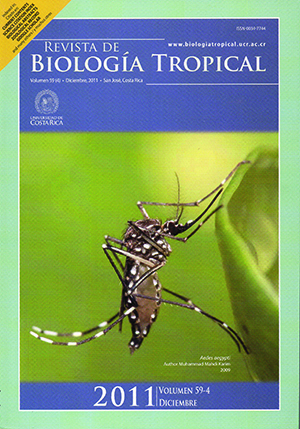Resumen
Postembryonic development, fecundity and food consumption of Dichroplus exilis (Orthoptera: Acrididae) under controlled conditions. Dichroplus exilis is a widely distributed species in Southern South America. Although there have been reports of D. exilis as an agricultural pest, some recent observations suggest that the damage attributed to D. elongatus may actually have been caused by D. exilis. This study was conducted to determine the postembryonic life cycle stages, fertility and food consumption of this species under controlled conditions (30°C, 14L-10D, 40% RH).Individuals employed belong to the laboratory-hatched first generation (F1), from adults (n=64, ?=28, ?=36) collected in natural grasslands near Rafaela, Santa Fe province in North- Eastern Argentina. Three cohorts of 16, 17 and 20 individuals were monitored independently in acetate tubes on a daily basis, until death of the last insect. Average fecundity was 381.84, 38.54 eggs per female. Egg-pod incubation time was 14.4, 1.08 days and six nymphal instars were recorded. Nymphal development time was 41.38, 0.71 days (I=8.73, 0.20; II=6.38, 0.24; III=5.64, 0.33; IV=7.15; 0.43; V=9.76, 0.54; IV=7.85, 0.95). The recorded food consumption was 9.89, 1.08 (mg/ind/day) for nymphs IV, 18.04, 0.73 (mg/ind/day) for nymphs V-IV, 16.76, 1.06 (mg/ind/day) for pre-reproductive males, 28.09, 1.81 (mg/ind/day) for pre-reproductive females, 7.71, 0.91 (mg/ind/day) for reproductive males and 13.06, 0.71 (mg/ind/day) for reproductive females, while the average adult food consumption, regardless of sex and reproductive status, was 16.41, 4.32mg/day. Average food consumption of adult females was 17.47, 1.15mg, and was significantly higher than that of males (10.83, 0.91mg). Data obtained in this study showed that D. exilis exhibits at least some of the biological attributes needed to configure an actual or potential agricultural pest, albeit not yet recognized as such. Field monitoring of grasshopper communities in areas where damage by D. exilis is suspected is envisaged in order to determine its possible status as a pest.Comentarios

Esta obra está bajo una licencia internacional Creative Commons Atribución 4.0.
Derechos de autor 2011 Revista de Biología Tropical
Descargas
Los datos de descargas todavía no están disponibles.






